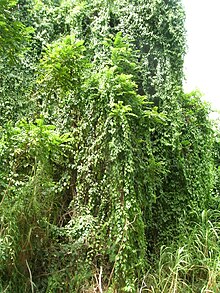Cissus verticillata, the princess vine[2] or seasonvine,[3] is an evergreen perennial vine in the grapevine family Vitaceae.
| Cissus verticillata | |
|---|---|
 | |
| Scientific classification | |
| Kingdom: | Plantae |
| Clade: | Tracheophytes |
| Clade: | Angiosperms |
| Clade: | Eudicots |
| Clade: | Rosids |
| Order: | Vitales |
| Family: | Vitaceae |
| Genus: | Cissus |
| Species: | C. verticillata |
| Binomial name | |
| Cissus verticillata (L.) Nicolson & C.E.Jarvis | |
| Synonyms | |
|
see text | |
Taxonomy
A large number of names have been synonymized to this species; currently 72 synonyms are recognized.[4]
Folk medicine
Historical folk medicine recommendations include "weakness of the stomach", fevers and antiepileptic action. The root bark was also chewed "to strengthen teeth".[5]
History and naming
Cissus verticillata (= C. sicyoides) was discovered in 1571 in Mexico (probably in what is today the state of Michoacán) and first described in 1574 by Nicolás Monardes who named in Spanish Carlo Sancto. In Europe the plant was compared to hop (Humulus lupulus L.) so it was named by Caspar Bauhin Lupulus Mechiocanus (which means "hop of Michoacán"). The roots of Cissus verticillata were exported to Europe as a medicinal stock. The last certain reports that this medicinal stock was present in European market originate from the decline of the 18th century[5]
References
Wikiwand in your browser!
Seamless Wikipedia browsing. On steroids.
Every time you click a link to Wikipedia, Wiktionary or Wikiquote in your browser's search results, it will show the modern Wikiwand interface.
Wikiwand extension is a five stars, simple, with minimum permission required to keep your browsing private, safe and transparent.


